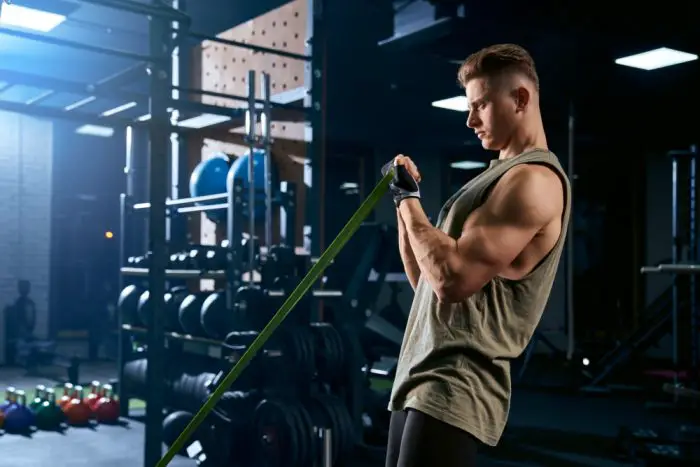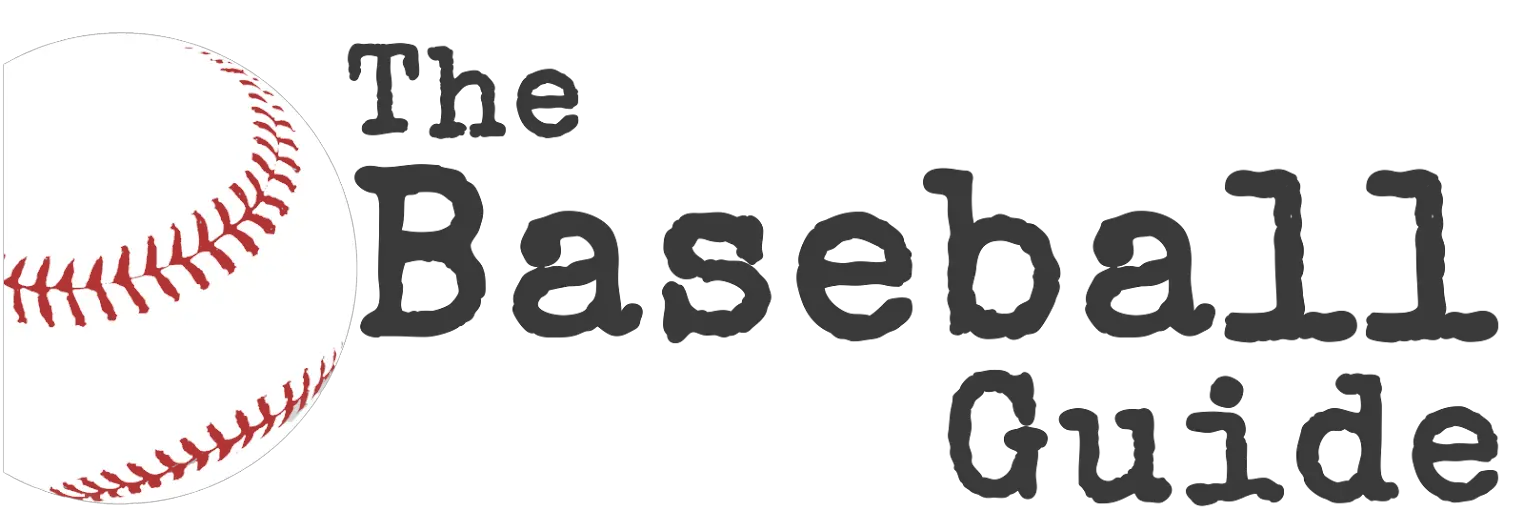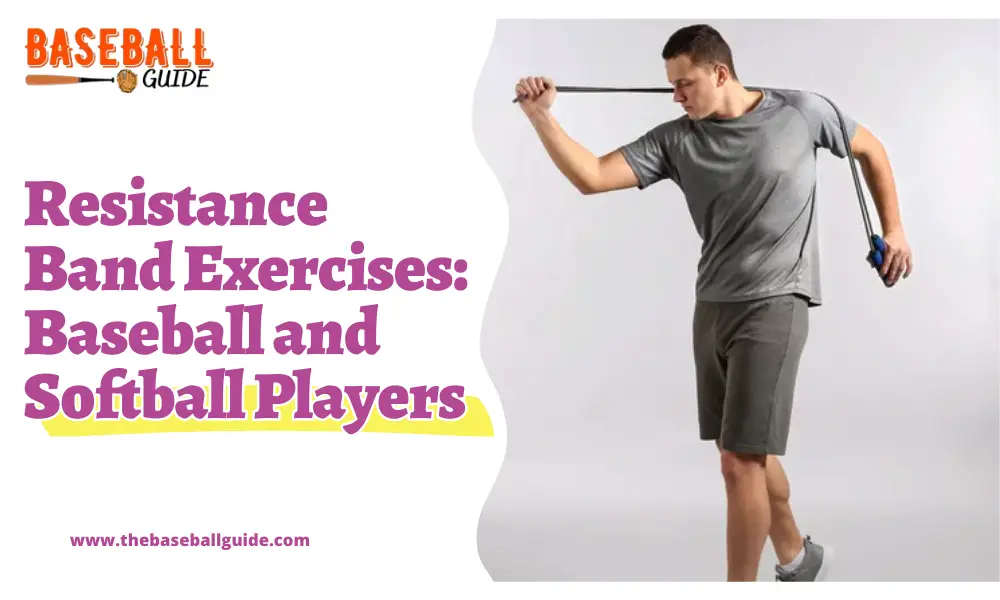How excited were you to learn that a simple big elastic band, known as a “resistance band,” may help you improve your baseball skills?
It must have been more than usual, as you can now have a new set of fun and simple exercises to add to your workouts.
After all, how tough do you believe rubber band exercises can be?
Using stretch bands for baseball and softball practice is an excellent training aid for players.
I’ve mentioned several resistance band workouts in this post that you may do as a baseball or softball player to improve your overall performance.
Boosting Baseball and Softball Performance with Resistance Band Exercises
- Resistance band exercises are great for improving strength, flexibility, and power in baseball and softball players.
- Rotational rows target the upper back and core, while shoulder presses focus on the shoulders.
- Squats work the legs, and bicep curls target the biceps, which are important for throwing and hitting.
- Resistance band exercises should be incorporated into a player’s training routine for optimal results.
Resistance Band Exercises for Targeted Muscles and Their Benefits
Exercises | Targeted Muscles | Benefits | Difficulty |
Pullover | Back and chest | Stabilize chest muscles and improve endurance for overhand throwing action | |
Throwing motion | Shoulders, back, chest | Improves blood flow to targeted muscles, reducing injury risk | |
Internal rotation | Chest and front shoulder | Reduces shoulder injury risk and strengthens the shoulder | |
Internal rotation at 90 degrees | Subscapularis | Activates a key “internal” rotator and shoulder’s primary anterior stabilizer | |
Internal rotation at 0 degree | Subscapularis | Aids in proper “ball and socket congruence” | |
External rotation | Rear shoulder and upper back | Strengthens and stimulates the infraspinatus and Teres Minor | |
Internal rotation at 90 degrees | Infraspinatus and Teres Minor | Focuses on bringing arm into “lay back” posture | |
External rotation at 0 degree | Infraspinatus | Usually done before external rotation at 90 degrees | |
Forearm curl | Forearm flexors | Strengthens grip and wrists for better bat control |
Top Resistance Band Exercises for Baseball and Softball Players

Like other baseball and softball workouts, the resistance band exercise plays an important role in injury prevention and skill development.
Continue reading to learn about some of the most basic workouts for using resistance bands to improve your gaming proficiency.
1. Pullover
Pullovers are an excellent way to work both your back and chest muscles in one exercise.
Although the chest muscle stabilizes, it is important in baseball’s overhand throwing action.
The overhand throwing motion is more endurance-based, particularly for pitchers, but strength helps throw the ball harder.
If you are doing pullovers using a resistance band, it is even better as there are no chances of an injury, and it becomes much more of a light exercise.
Pullovers help baseball and softball players stabilize their chest muscles.
To do a pullover using a resistance band, follow the following steps:
- Lie down on your back, knees bent, feet flat with the band anchored parallel to you.
- Keeping your arms straight above, grab the ends of the band.
- Pull the band toward your hips while keeping your elbows straight.
- Repeat several times (10-12) to form a set of this exercise.
Video Tutorial:
2. Throwing Motion
Blood flow to the muscles of the shoulder, back, and chest is improved by throwing motions. Therefore, injury risk can be reduced by adequately warming up such muscles.
For throwing motion:
- Use the carabiner clip to attach the band to a fence or a pole and fasten the velcro straps around your wrists.
- Your body should be facing away from the band so that the bands are behind you.
- Slowly mimic the action you make while throwing with both arms.
While doing the activity, keep your movements smooth and avoid overexerting yourself.
Video Tutorial:
3. Internal Rotation
Internal shoulder rotation exercises target the muscles in your chest and front shoulder.
Internal rotations with a resistance band are a fantastic choice for baseball and softball players because they reduce the risk of a shoulder injury and strengthen the shoulder, which is involved in practically all of the sport’s motions.
Video Tutorial:
3.1 Internal Rotation At 90 Degree
The pitcher’s subscapularis, a key “internal” rotator, and the shoulder’s primary anterior stabilizer are activated during this exercise.
3.2 Internal Rotation At 0 Degree
It is one of the best band workouts for pitchers because the subscapularis assists in depressing the shoulder joint into the glenoid, which aids in proper “ball and socket congruence.”
4. External Rotation
External shoulder rotation exercises target the muscles at the rear of your shoulder and upper back.
4.1 External Rotation At 90 Degree
This exercise strengthens and stimulates the infraspinatus and the Teres Minor, which is another key component of the posterior cuff and aids in external rotation.
You may use this exercise as a pitcher to bring your arm into the “lay back” (gas) posture.
To perform external rotation at 90 degrees:
- Secure one end of the band to a solid object and face it with your non-working arm closest to the attachment point.
- Lift your arm until your shoulder is at a 90-degree angle, and keep your elbow at shoulder height while holding on to the band with your palms down.
- Pull the band away from the point where it is attached and slowly bring it back in.
4.2 External Rotation At 0 Degree
Perform external rotation while the pitcher’s shoulder is zero degrees because it focuses more on the infraspinatus. This is usually done before external rotation at 90 degrees.
To do an external rotation at 0 degrees:
- Secure one end of the band to a solid object and stand beside it with your non-working arm closest to the object.
- Hold on to the end of the band with an elbow bent 90 degrees and your forearm flat on the ground.
- Pull the band away from the point where it is attached and slowly bring it back in.
5. Forearm Curl
The ability to whip the bat through the playing field necessitates having strong forearms.
Strengthening your grip and wrists might help you put that final push behind the ball when you make contact.
When you curl your forearms with a resistance band, you work your forearm flexors, which are the muscles on the bottom of your arm.
To do forearm curls with a resistance band:
- Use an overhand grip to hold the resistance band handles out front of your body.
- Then, stretch your hands towards the bottom of your forearms with effort.
- While squeezing to intensify the contraction, slowly release your forearms so that they return to their original position.
Video Tutorial:
6. Banded Victory
The rotator cuff muscles on the rear of the shoulder can be strengthened by performing this exercise in the overhead position.
To do the banded victory exercise:
- Attach a band to the side of a strong item.
- Facing the band, make a four-foot-long backward motion while holding the band.
- Adjust the distance between your legs so that they’re shoulder-width apart, and lower yourself into a quarter squat position with both arms extended.
- Place your palms on the floor with the palms facing down, then raise your shoulders.
- Slowly lift your arms overhead in a “victory” (Alphabet ‘Y’)configuration while maintaining your elbows straight.
7. Glute Walk
The glute walk engages the muscles involved in the hip joint’s external rotation.
The glute walk is an excellent way to activate the hip’s external rotators and provide a powerful front side when hitting.
To do glute walk:
- Wrap both legs in the short loop band and place it above the knee joint.
- Put yourself in a ready stance like an outfielder by bending your knees and sitting on your hips.
- Take a heel-to-toe step to the right, about 1 to 2 inches in length.
- Step right 1 to 2 inches with the left foot.
Benefits of Resistance Band Exercises
Resistance band exercises offer many benefits to baseball and softball players, including improved strength, power, and flexibility.
In addition, these exercises can target specific muscles used in baseball and softball, helping players develop the strength and endurance necessary to perform at their best.
Improved Strength, Power, and Flexibility
Resistance band exercises use the tension of the bands to provide resistance against the movement, which can help to increase overall strength and power.
By engaging the muscles through a full range of motion, resistance band exercises can also improve flexibility and joint mobility.
This can help baseball and softball players move more efficiently and with less risk of injury.
Targeted Muscle Development
Resistance band exercises can be tailored to target specific muscles used in baseball and softball.
For example, exercises like the rotator cuff external rotation can help strengthen the shoulder and prevent injuries in pitchers, while lateral walks and glute bridges can help improve hip mobility and stability, which are important for hitting and fielding.
Incorporating resistance band exercises into a regular training routine can help baseball and softball players develop the strength, power, and flexibility necessary to perform at their best and reduce the risk of injury.
Conclusion
Resistance band workouts help increase blood flow and activate the throw-specific shoulder and cuff muscles; pitchers benefit the most from them.
With a resistance band, you may quickly intensify several common activities in your workout routine, such as push-ups.
Resistance bands are mostly used for warm-ups and injury prevention, but they may also be utilized to make simple workouts more strenuous.
So, the next time you take your band out, don’t forget to add the exercises to the list above.


